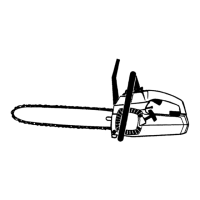TYPES OF CUTTING
A. BASIC CUTTING TECHNIQUE
1. IMPORTANT POINTS
a. Cut wood only. Do not cut metal;plastics;ma-
sonry; non-wood building materials; etc.
b. Stop the saw if the chain strikes a foreign
object. Inspect the saw and repair or replace
parts as necessary
c. Keep the chain out of dirt and sand. Evena
smallamountof dirtwill quicklydull a chain
andthusincreasethepossibilityofkickback.
A WARNING
Kickback can occur when the moving chain con.
tacts an ob”ect at the upper portion of the tip of
ithe guide ar or when the wood closes in and
pinches the saw chain in the cut. Contact at the
f
u perportion of the tip of theguide bar can cause
t e chain to dig into the object and stop the chain
for an instant. The result is a lightning fast, re-
verse reaction which kicks the guide bar up and
back toward the operatoz If the saw chain is
~
inched along the top of the guide bafi the guide
ar can be driven rapidly back toward the opera-
ton Either of these reactions can causeloss of saw
control which can result in serious iniurv.
Figure 16
2.
3.
UNDERSTANDING REACTIVE FORCES
Pinch-kickback and Pull-In occur when
the chain is suddenly stopped by being
pinched, caught, or by contacting a foreign
object in the wood. This sto ping ofthe chainre-
?
sultsin areversal ofthechain orceusedto cutwood
andcausesthe sawtomove intheoppositedirection
of chain rotation. Either reaction can result in loss
of control andpossible serious injury.
● Pinch-Kickback- -
--occurs when the chain on top of the bar is sud-
denly sto peal.
3––rapidly rives the saw straight back toward the
operatoz
. Pull-In--
- -occurs when the chain on the bottom of the bar
is suddenlystopped.
––pulls the saw rapidlyforward.
PROCEDURE
Practice cuttinga fewsmalllogsusingthefollowing
technique to getthe “feel” ofusingyour sawbefore
you bean a maior sawing oDeration.
a.
b.
c.
d.
e.
f.
g.
Ac&elerat~ engine-to”full throttle before
entering cut by squeezing the throttle trigger.
~fegii cutting with the saw frame against
5
Figure 16.
Keep t” e engine at full throttle the entire
time you are cutting.
Allow the chain to cut for you; exert only
light downward pressure. If you force the cut,
damageto the bar,chain, or engine can result.
Release the throttle trigger as soon as the
cut is com leted, allowing the engine to idle.
f
Ifyou runt e saw at full throttle without a cut-
ting load, unnecessary wear can occur to the
chain, bar,and engine.
To avoidlosingcontrol when cut iscomplete,do
not put pressure on saw at end of cut.
Stop the engine before setting the saw down
after cutting.
B. TREE FELLING TECHNIQUES
1. CAREFULLY PLAN YOUR SAWING OPERA-
TION IN ADVANCE
a.
b,
c.
d.
e.
– 12-
Clear the work area. Clear the area all
around the tree so you can have secure footing.
Study the natural conditions that can cause
the tree to fall in a particular direction.
1.) The WIND direction and speed.
2.) The LEAN of the tree. The lean of a tree
might not be apparentdueto uneven or slop-
ing terrain. Use a plumb or level to deter-
mine the direction of tree lean.
3.) WEIGHTED and BRANCHES on one side.
4.) Surrounding TREES and OBSTACLES.
Look fordecay and rot. Ifthetrunk isrotted,
it can snap and falltoward the operator.
Check for broken or dead branches which
can fall on you while cutting.
Make sure there is enough room for the
tree to fall. Maintain a distance of 2 1/2 tree
lengthsfrom thenearestpersonor otherobjects.
Engine noise can drown out a warning call.
f. Remove dirt, stones, loose bark, nails, staples,
andwirefromthetreewherecutsaretobemade.
g. Plan to stand on the up-hill side when cut-
ting on a slope. Figure 17.
h. Plan aclearretreat nathto therearanddia~-
onal to the line of fall.””Figure18.
\
4&
‘%8
-----
0
t-
45°
/
‘MA%#~
Direction
-+-
Of Fall
Stay On Uphill Side Of
/v
Tree When Felling
—.
.— —.
Figure17 Figure 18

